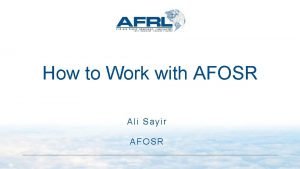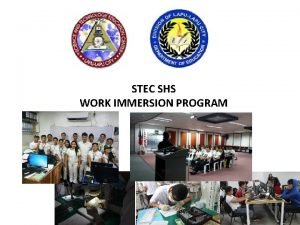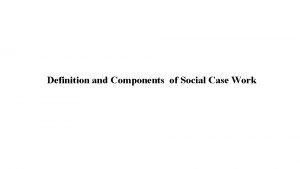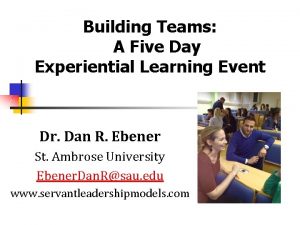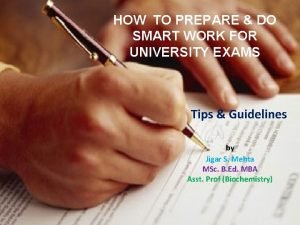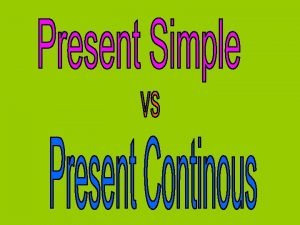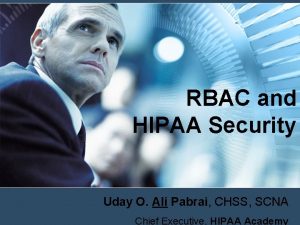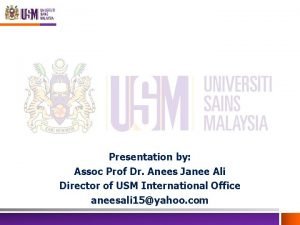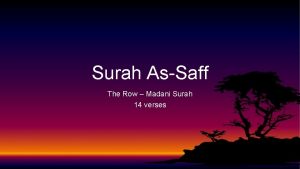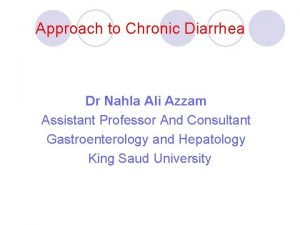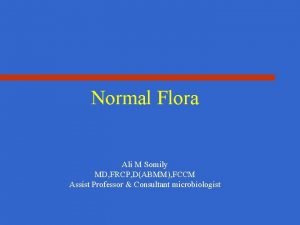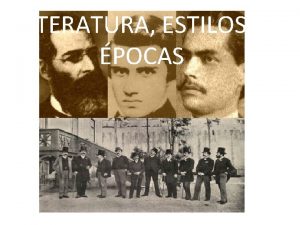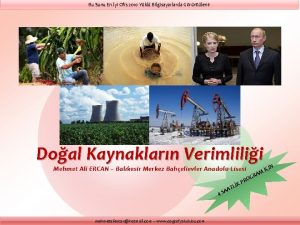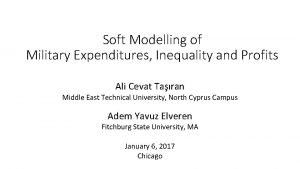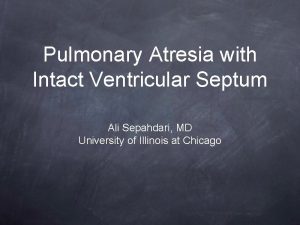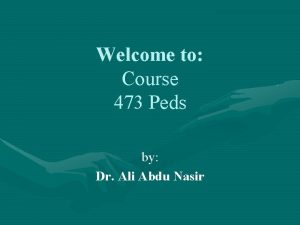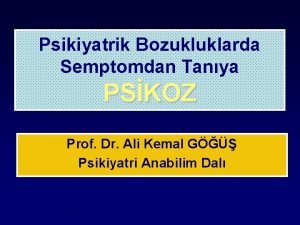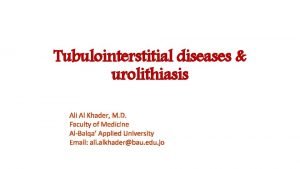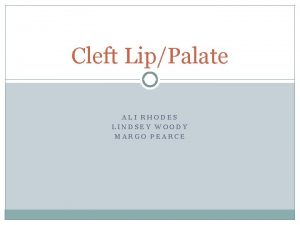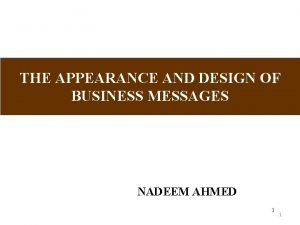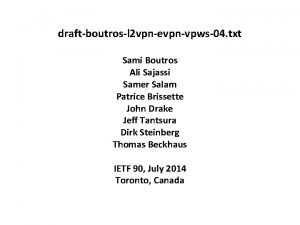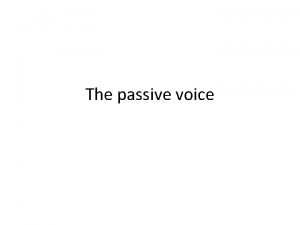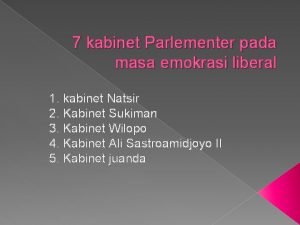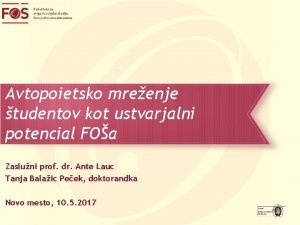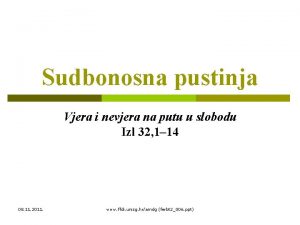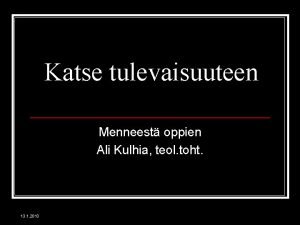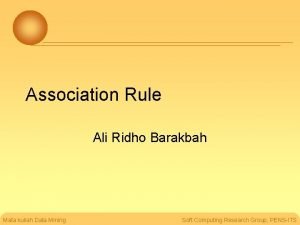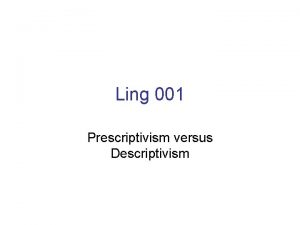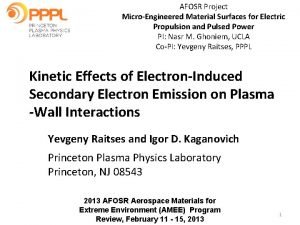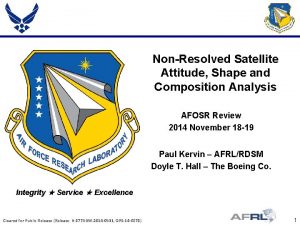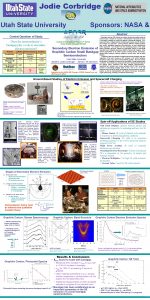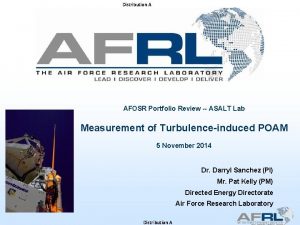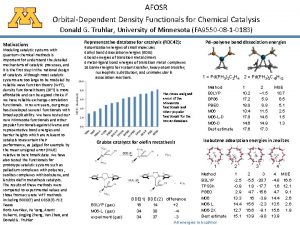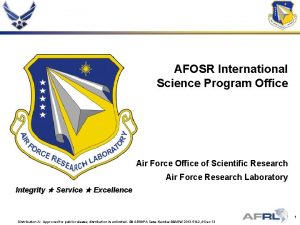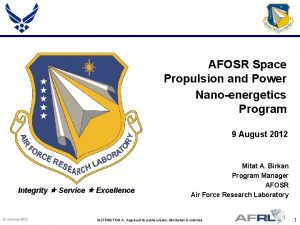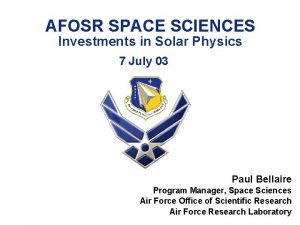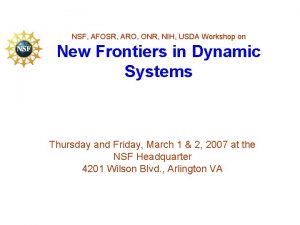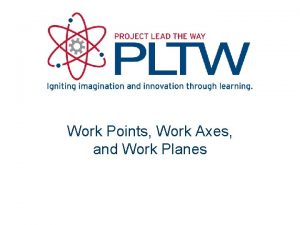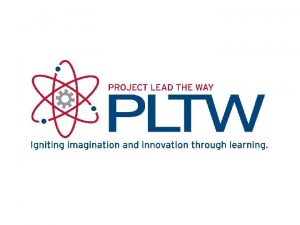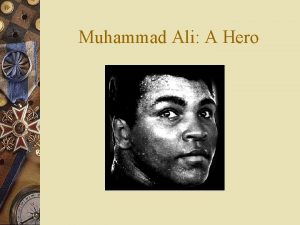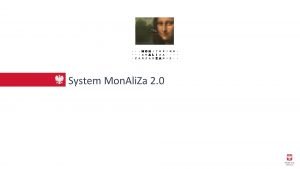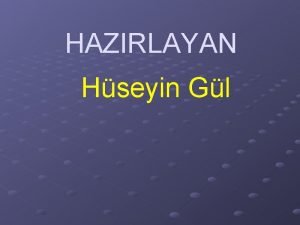How to Work with AFOSR Ali Sayir AFOSR








































- Slides: 40

How to Work with AFOSR Ali Sayir AFOSR

Air Force Research Laboratory Space Vehicles Materials & Manufacturing Information Aerospace Systems Munitions 711 th Human Performance Wing Directed Energy Sensors Air Force Office of Scientific Research 2

AFRL Top Priorities Hypersonics Autonomy Directed Energy Cyber 3

UNDERSTANDING AFOSR 4

AFOSR Locations 5

6

Portfolio Organization Basic Research Division (RT) Engineering and Information Science Branch (RTA) Physical and Biological Science Branch (RTB) Eng. /Complex Systems Information & Networks Physical Science Multi-Scale Structural Mechanics and Prognosis Computational Cognition & Machine Intelligence Quantum Information Science Turbulence and Transition Information Operations and Security Test and Evaluation Flow Interactions and Control Energy Conversion and Combustion Sciences GHz-THz Electronics Dynamic Materials and Interactions Low Density Materials Space Propulsion and Power Aerothermodynamics Dynamic Data Driven Applications Systems and Software Trust and Influence Science of Information, Computation and Fusion Computational Mathematics Dynamics and Control Complex Networks Optimization and Discrete Mathematics Atomic and Molecular Physics Ultrashort Pulse Laser-Matter Interactions Remote Sensing and Imaging Physics Optoelectronics and Photonics Aerospace Materials for Extreme Environments Quantum Electronic Solids Electromagnetics, Sensing, Surveillance, and Navigation Plasma and Electro-Energetic Physics Laser and Optical Physics Space Sciences Chem. /Bio Science Natural Materials & Systems Mechanics of Multifunctional Materials and Microsystems Human Performance and Biosystems Organic Materials Chemistry Molecular Dynamics and Theoretical Chemistry Biophysics 7

How to Work with AFOSR 8

ACADEMIA 9

Review Broad Agency Announcements • Researchers should visit www. grants. gov – the official source for finding and applying to Federal grants • Find opportunities that match interests. Search by: • Keyword • Eligibility • Category • Agency etc. • Study and keep current with BAAs • Attend program reviews to understand the directions and needs of program 10

Scope and Draft Idea Statement • Statement doesn’t have to be all-inclusive, but should address the unique value proposition of the research • Statement needs to be specific enough that it catches the interest of the Program Officer 11

Connect with Program Officer • At this point, some Program Officers will want a specifically formatted white paper • Others will want to have a conversation • In person • Over the phone • Via email • If the idea seems promising, Program Officer will initiate an on going dialogue setting expectations and explaining the process for full proposal submission. 12

Program Manager Roles • Topical / Program Expert • Educator / Communicator • Team Builder • Advocate • Evaluator • Administrator • Active Member of AFRL, Do. D & Scientific Communities Program Officers’ empowerment is a key component of our success 13

Determine the Correct Funding Mechanism • There a number of different mechanisms for universities to obtain basic research grant funding: • Traditional grants • University Research Initiatives (i. e. MURI, DURIP) • Special Programs (i. e. HBCU/MI, YIP) • Traditional grants can be awarded year round from the general BAA • Other opportunities have specific deadlines 14

Submit Full Proposal • Full proposals should include • Strong technical merit • AF relevance • Solid budget justifications • Full details can be found in the BAA • Grants. gov also provides a number of tutorials for using the site 15

Peer Review TECHNICAL: Proposal subject area is appropriately addressed in the AFOSR BAA. • What will be the results of this work and how novel are they? : • How will the results advance the state of the art and how significant will the advancement be? : • Will the proposed approach produce the desired results? What are its strengths and weaknesses? : • Comment on the key personnel's qualifications, capabilities, related experience, and past performance. : • Additional comments and relevant issues? : RELEVANCE & RELATION OF AF: OTHER CRITERIA: • • Comment of the adequacy and/or availability of the facilities, equipment, hardware, simulation tools and techniques integral to the objectives of the proposed research. : Comment on the realism and reasonableness of the proposed project cost. : IS THERE AN ASPECT OF THE PROPOSED RESEARCH THAT WILL LEAD TO A SIGNIFICANT TRANSFORMATION IN OUR UNDERSTANDING OF THE STATE-OF-THE-ART? IF SO, PLEASE BRIEFLY DESCRIBE THE TRANSFORMATIONAL ASPECT OF THE WORK. 16

Budget Justification • For Personnel Management: Discuss realism and reasonableness of the (a) number of personnel, (b) labor mix, (c) level of effort etc. • For Permanent Equipment (>$5, 000/unit and useful life > 1 year) Are all the permanent equipment items special purpose and/or test equipment, interconnected and interdependent, reasonable and acceptable for the work to be performed and of significant value to the project. • Consumables and facility Chargers: Provide JUSTIFICATION and explanation with respect to proposed research. Provide quotations and/or links to the price structure of consumables, materials supplies, and facility charges. • Other Direct Costs Provide Justification for direct costs • Travel: For travel or quantity of trips, (a) rationale for travel, (b) the amount of travel or quantity of trips, and (a) the number of personnel traveling in terms of realism and reasonableness for the work • Subcontract: Discuss (a) rationale for these costs, (b) why it is necessary, (c) what does it add to the research, and (d) why can it not be accomplished by the awardee/grantee. 17

Get Funded! Get started and stay involved • POs weigh several factors in selecting proposals for funding: • Identify overlap with program interests, and connecting to DODS labs • Potential for scientific breakthroughs • Strategic directions • Budget realities • Peer review to gauge scientific merit • Once funded, remain engaged and continue with the process. • Continue reviewing BAAs • Attend program reviews • Collaborate with other PIs in the program 18

2017 Young Investigators Program 19

YIP/PECASE Program Foster creative basic research in science and engineering, enhancing early career development of outstanding young investigators who have demonstrated exceptional ability and promise for conducting basic research and potential for leadership in the community 20

Portfolio Organization Basic Research Division (RT) Engineering and Information Science Branch (RTA) Physical and Biological Science Branch (RTB) Eng. /Complex Systems Information & Networks Physical Science Multi-Scale Structural Mechanics and Prognosis Computational Cognition & Machine Intelligence Quantum Information Science Turbulence and Transition Information Operations and Security Test and Evaluation Flow Interactions and Control Energy Conversion and Combustion Sciences GHz-THz Electronics Dynamic Materials and Interactions Low Density Materials Space Propulsion and Power Aerothermodynamics Dynamic Data Driven Applications Systems and Software Trust and Influence Science of Information, Computation and Fusion Computational Mathematics Dynamics and Control Complex Networks Optimization and Discrete Mathematics Atomic and Molecular Physics Ultrashort Pulse Laser-Matter Interactions Remote Sensing and Imaging Physics Optoelectronics and Photonics Aerospace Materials for Extreme Environments Quantum Electronic Solids Electromagnetics, Sensing, Surveillance, and Navigation Plasma and Electro-Energetic Physics Laser and Optical Physics Space Sciences Chem. /Bio Science Natural Materials & Systems Mechanics of Multifunctional Materials and Microsystems Human Performance and Biosystems Organic Materials Chemistry Molecular Dynamics and Theoretical Chemistry Biophysics 21

GHz ELECTRONICS AND MATERIALS PM: Ken Goretta • Oxides: materials systems, synthesis, heterostructures, defects (especially interfaces), structure/property relations, theory • 2 -D materials/heterostructures: defects, interfaces, 2 -D/3 -D integration, electrical contacts, emerging physics, device design and fabrication • Reconfigurable devices (mostly physical reconfiguration): materials, mechanics, actuation control, theory and design, performance 100 Reasonable current at large VB 6 H-Si. C Si 10 -2 RON (Ω∙cm 2 ) • UWBGs: synthesis, alloying, doping, heterostructures (including 2 -D electron and hole gases), defects, thermal management, electrical contacts, characterization, modeling/theory 10 -4 Al. N 4 H-Si. C Ga. N 10 -6 FOM = • THz speeds / materials for quantum systems: fundamental physics and control thereof, design, nanofabrication • Balance classical superconductivity & quantum information science investments VB 2 RON 10 10000 VB (V) • Sensors/detectors: identifying the most promising basic research directions (AFRL workshop in Spring 2019) 22

DYNAMICS MATERIALS AND INTERACTIONS PM: Martin Schmidt • Lack of predictive understanding requires long development times and large resource investment for new explosive formulations • Dynamic response of heterogeneous materials is complex and continuum response depends on the stochastic mesostructure • How do you bridge the multiple length and time scales involved • How do you account for material heterogeneity at the continuum • Mesoscale validation experiments are extremely challenging but critical to code validation and model development • How to realize the promise of increased energy density from reactive materials 23

MULTISCALE STRUCTURAL MODELING AND PROGNOSIS PM: Jay Tiley • Need to integrate different mechanics models across multiple length scales (crystal plasticity modeling, characterization tools for verification, quantifying uncertainty… when is good enough? ) • Need for coupling physics based models to address hypersonic air flow interactions with compliant structures (thermal, acoustic, and mechanical models… what is truly important to capture behavior? ) • Need for high velocity data sets for verification of damage models and mechanical behavior across entire flight regimes (need for accurate structural load data… why do structures fail? ) Dramatic stiffness change with simple actuation mechanism through structural locking of origami • Need for new aerospace design paradigms (structural optimization, novel configurations… how can we improve capabilities? ) 24

ORGANIC MATERIALS CHEMISTRY PM: Ken Caster RESEARCH AREAS • • Photonic Materials Electronic Materials Novel Properties Nanoscience SCIENTIFIC DRIVERS • Fundamentals understanding ‒ Precise control: composition, connectivity, structure, morphology, topology, selfassembly, length scale, structure/property ‒ Design rules: catalysts, material properties, conversion/selectivity ‒ On-demand: enabling chemistry, materials, tunable properties ‒ Characterization: full analysis, new methods ‒ Computational models and simulations: new, faster/more accurate ‒ Interdisciplinary approaches 25

MECHANICS OF MULTIFUNCTIONAL MATERIALS & MICROSYSTEMS B. L. (Les) Lee DESIGN INSPIRED BY BIOLOGY: Ø “Autonomic” systems that can sense, diagnose and respond for adjustment with minimum external intervention Ø “Adaptive” structures allowing reconfiguration of shape, functionality and mechanical properties on demand Ø “Self-sustaining” systems with structurally integrated power sources and self-regulating thermal management Ø Incorporating active elements of “programmable” materials in “multiscale” architectures 26

AEROSPACE MATERIALS FOR EXTREME ENVIRONMENTS PM: Ali Sayir RESEARCH AREAS : AREAS OF EMPHASIS: I. Predictive Materials Science (1) Quantum Materials: • Synthesis science • Supersaturated lattice designer atoms (defects) II. Electromagnetic Coupling with Structure of Material • Metal-Dielectric Interface • β-Ga 2 O 3 • Beamed Energy: mm – wave III. Hypersonic Materials 1. Entanglement distribution 2. Highly entangled states (graph states) Requirements: • picometer resolution • validating ultra-fast time dynamics Metric: • • • the design of tunable elements and defects ability to tune continuously the fundamental Coulomb interactions, and carrier hopping magnetic interactions that govern correlated behavior. (2) Science of Rare Events: 27

MURI TOPICS • A. Sayir – 2018 • M. Birkan and A. Sayir – 2017 b-Ga 2 O 3 as a High-Critical Field Strength Materials for Power Systems Piezoelectric Nanoenergetic Materials with Adaptable and tailorable Reactivity • A. Sayir, T. Nguyen, and J. Prater – 2016 Adaptive Oxides: Biologically Emulative Functions via Modulation of Internal States • J. –L. Cambier, T. Curcic, and A. Sayir – 2016 Revolutionary Advances in Computational Quantum Many Body Physics • M. Birkan and A. Sayir – 2014 Control of Coherent Structures in Plasmas for Reconfigurable Metamaterial-Based Devices • R. Parra and A. Sayir – 2014 Strong Field Laser Matter Interactions at Mid-Infrared Wavelengths • A. Sayir and J. Luginsland – 2013 Magneto-electric Energy Conversion Materials: Terahertz Emission and Efficient Energy Conversion in Unbiased Dielectrics • D. Stargel, F. Fahroo, and A. Sayir – 2013 Multiphysics and Multiscale Failure Predictions through Peridynamic Theory • A. Sayir – 2012 Directional Eutectic Structures: Self-Assembly for Metamaterials and Photonics • F. Fahroo and A. Sayir – 2012 Managing Informational Complexity in Predictive Materials Science 28

What kind of Dinner is this? MUTAGENESIS OF THE CA 2+-DEPENDENT PHOTOPROTEIN, AEQUORIN 29

• DISTRIBUTION C: Distribution to U. S. Government agencies and their contractor’s. To protect draft, planning, or other preliminary information from premature dissemination. Other requests for this document shall be referred to AFOSR/ITA 30 30

Wisdom of the Crowd Thomas Edison, 1889 "Fooling around with alternating current is just a waste of time. Nobody will use it, ever. " First successful test of electric light bulbs was on October 22, 1879. 31

Questions? 32

AFOSR OVERVIEW • Responsibility: Manage the basic research investment for the United States Air Force • Mission: Discover, shape, and champion science that profoundly impacts the future Air Force • Activities (as of March 2015) – Over 340 intramural research projects, 320 international grants, and 1350 U. S. research grants at more than 200 U. S. universities – Supporting over 1600 Principal Investigators, 3200 grad students, and 600 post-docs • Funding – Approximately $500 M in FY 15 33

Turning Science Into Capability Initial Operating Capability Timeline 34

OCONUS Grants by Country 35

2017 Young Investigators Program • DISTRIBUTION C: Distribution to U. S. Government agencies and their contractor’s. To protect draft, planning, or other preliminary information from premature dissemination. Other requests for this document shall be referred to AFOSR/ITA 36

2017 Historically Black Colleges/Universities • DISTRIBUTION C: Distribution to U. S. Government agencies and their contractor’s. To protect draft, planning, or other preliminary information from premature dissemination. Other requests for this document shall be referred to AFOSR/ITA 37

2018 Centers of Excellence 38 • DISTRIBUTION C: Distribution to U. S. Government agencies and their contractor’s. To protect draft, planning, or other preliminary information from premature dissemination. Other requests for this document shall be referred to AFOSR/ITA

AFOSR Funding 21% Overhead $71. 5 M YIP $18. 4 M 52% CORE Extramural $178. 8 M 24% Intramural $178. 8 M COE $3. 9 M 3% IO $11. 6 M HBCU/MSI $4. 5 M ($M) 2017 2018 2019 Core Basic Research 343 348 University Research Initiative 146 163 155 Total 489 506 503 10% Overhead $14. 9 M 32% S&E Education $46. 5 M NDSEG $43. 2 M 46% S&T Grants $67. 8 M DURIP $18. 6 M MURI $60. 2 M 12% S&T Instrument & Equipment $16. 8 M 39 39

Develop a Research Plan • Personal drive plays a huge role in this step • Advisors and mentors are often helpful in steering researchers to areas with available funding like national defense • Position oneself as a scholar, a researcher, and a grant writer • Author publications • Contribute to community (present and get feedback) • Join professional societies • Serve on review panels • Develop long-term research goals • Understand leverage resources • Identify a unique value proposition 40
 Ali sayir
Ali sayir Work immersion checklist
Work immersion checklist Remedial model in social work
Remedial model in social work Chapter 4 work and energy section 1 work and machines
Chapter 4 work and energy section 1 work and machines Work immersion goals
Work immersion goals Components of social case work ppt
Components of social case work ppt I work all day i work all night to pay the bills
I work all day i work all night to pay the bills Hard work or smart work
Hard work or smart work Team vs group
Team vs group Smart work vs hard work group discussion
Smart work vs hard work group discussion Work present continuous
Work present continuous Physics 03-01 work and the work-energy theorem
Physics 03-01 work and the work-energy theorem Work ethics for work immersion
Work ethics for work immersion Uday ali pabrai
Uday ali pabrai Petas usm
Petas usm Surah 14
Surah 14 Chronic diarrhea
Chronic diarrhea Flora ali
Flora ali Ali veríeis galantes pintados de preto e vermelho
Ali veríeis galantes pintados de preto e vermelho Mehmet ali ercan sunuları
Mehmet ali ercan sunuları Ali cevat taşıran
Ali cevat taşıran Ali sepahdari
Ali sepahdari Md afsar ali
Md afsar ali Dr ali course
Dr ali course Psikoz
Psikoz Ali kıncal
Ali kıncal Ali al khader
Ali al khader Margo pearce
Margo pearce Optional parts of business letter
Optional parts of business letter Ali sajassi
Ali sajassi Ali eats
Ali eats 7 kabinet pada masa demokrasi liberal
7 kabinet pada masa demokrasi liberal Low and high friction
Low and high friction Mustapha kara-ali
Mustapha kara-ali željeno ali želeno
željeno ali želeno Nevjera ali umire
Nevjera ali umire Ali kulhia
Ali kulhia Dr ali moradi
Dr ali moradi Ali ridho barakbah
Ali ridho barakbah Samir ould ali inserm
Samir ould ali inserm Descriptive grammar
Descriptive grammar
